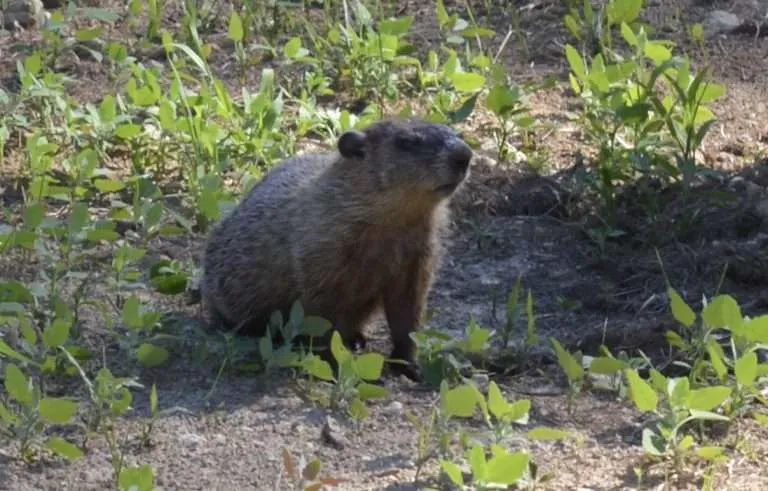Out in the Woods
- August 30th 2024
- Out in the Woods

A woodchuck forages in a field about 100 feet from its burrow under a wood pile.
How Many Veggies Could a Woodchuck Chuck?
Photo: Kevin McKeon
By Kevin McKeon, Maine Master Naturalist
This summer, for the third time in six years, we had a woodchuck take up residence under our tool shed at the Sanford Community Garden. This character followed on the heels of a pair of hares that also decided to use the garden as their personal smorgasbord. These visitors were not at all frustrated by either the deer fencing or the rabbit fencing installed at the garden’s birth. The hares disappeared by natural means shortly after a bobcat showed up near the garden. But it took a Havahart trap to oust the woodchuck.
Critters will navigate toward and live where the habitat is most optimal for their survival, so what better place for this pesky rodent than a burrow under a building, in the middle of a fenced garden? Even though we’ve relocated several of these vegetable-gnawers — and undoubtedly will do so again — there’s obviously a trail sign somewhere advertising an available residence to other migrating woodchucks!
Woodchucks were called woodchoock, woodshaw, and wejack by some Native American cultures; to the indigenous Cree, they were wuchak. So that’s probably how we came by their current name. Back in the day, folks called them earth pigs and whistle pigs, referring to the sound they make when startled. When threatened, their teeth chatter a warning. They’re essentially giant ground squirrels and are the largest member of that family, usually growing to 10 pounds — up to 15 pounds prior to hibernation when they’re all fattened up — and 2 feet long, with a 6-inch bushy tail. They’ll live three to four years naturally, but up to eight years in captivity. They’re rodents, not quite the largest (that’s the beaver). The three or four baby woodchucks —chucklings, pups, or kits — born in April will migrate to their own foraging territories by July, during which time many fall prey to various canines and large raptors.
Woodchucks are good swimmers and can run 10 mph in short bursts. They forage within a half-mile range from their burrows, mostly along the ground in the morning and late afternoon, sometimes climbing shrubs and trees, eating the fruit, buds, leaves, and bark of plants, occasionally eating insects and eggs. They feed heavily in summer and early fall, growing fat reserves for their winter’s sleep. Woodchucks are one of Maine’s three true hibernators, along with jumping mice and bats. They retreat to one of their deeper burrows, curl into a ball, and their heart rate drops from 75 beats per minute to four. Other non-hibernating forest critters like skunks, opossum, raccoons, rabbits, weasels, and foxes will use woodchucks’ shallower burrows for their winter shelters.
So why do these rodents show up around our gardens? Well, they dig — a lot — and the typical sandy loam soil in our gardens is prime digging territory. Their short, powerful legs, flattened feet and long, curved claws make great excavation equipment, and flaps on their ears can shut to keep out dirt. Their burrow system of tunnels can be 45 feet long, with the vegetative-lined nesting chamber deep inside, protected from their wolf, coyote, dog, bobcat, and bear predators.
So now for the big question: How much wood would a woodchuck chuck if a woodchuck could chuck wood? Well, a few years ago, Richard Thomas, a New York State wildlife expert, measured the volume of various woodchuck burrows, and converted that estimate into cubic feet. Using an approximate weight of a cubic foot of soil versus a cubic foot of wood, Mr. Thomas concluded that a woodchuck could chuck 700 pounds of wood a day — “…if a woodchuck could chuck wood!” Thank God someone finally settled that!
Hibernators: https://sanfordspringvalenews.com/sleep-comes-in-many-forms/






